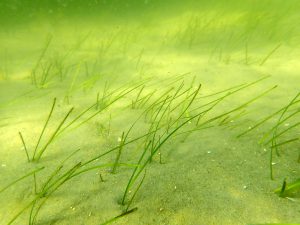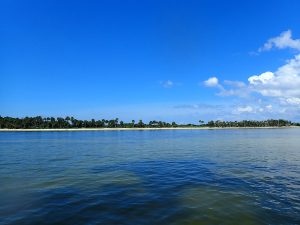By Alexandra L. Bijak, Ph.D. Student
UF/IFAS Soil and Water Sciences Department

World Seagrass Day (March 1st) raises awareness of seagrasses and the ecosystem functions and services they provide. Seagrasses are flowering marine plants that inhabit coastlines worldwide, except for in Antarctica. They evolved from land plants approximately 100 million years ago. Seagrasses have adapted to living and reproducing in the marine environment: their leaves bend and sway with the current and their pollen disperses through the water column or on the surface. Seagrasses are food sources for small invertebrates and larger animals, including fish, turtles, manatees, and even some sharks. They also provide a nursery habitat for commercially harvested fish and shellfish and can stabilize sediments, improve water quality and store large amounts of carbon. According to some estimates, Florida is host to the largest, continuous seagrass meadows in the world.
Florida’s Seagrasses

Seagrass meadows in the Big Bend region along the northwest Florida coast span nearly 240,000 acres 1. They are economically important to the region because they support clam, oyster, and other shellfisheries. Recreational scallop harvesting (scalloping) also is a popular summer activity that contributes to the economy. Just 2.5 acres of seagrass can support nearly 100,000 fish and 100 million invertebrates 2. Seagrasses support fisheries in two ways: their canopy and dense root system provide shelter from predators for small fish and invertebrates, and as dominant subtidal primary producers, seagrasses form the base of coastal food webs.
Ecosystem Services

Seagrasses also generate ecosystem services or functions we value as a society. One of these services is carbon capture. Seagrasses can baffle wave energy, causing suspended particles to deposit on the sediment surface where they can be buried under accumulating sediment over time. Through this mechanism, seagrasses can trap carbon from decaying plant material and other sources of organic matter. Once buried to depths where oxygen does not penetrate, carbon is stabilized because it is no longer available to microbes as an energy source. Worldwide, seagrass sediments contain an estimated 4,200-8,400 Tg (Tg =1012 grams) of organic carbon. This storage capacity is nearly twice the amount of carbon on a per-area basis compared to terrestrial soils 3. With increasing atmospheric carbon dioxide levels and associated climate effects, carbon storage in seagrass sediments presents a natural method for carbon capture. The recent development of carbon offset accounting methods for seagrass meadows 4 will allow seagrass restoration projects to earn carbon credits.
Current Research

Yet seagrass meadows vary in how much carbon they store from place to place and meadow to meadow. I am working with Dr. Laura Reynolds and Dr. Ashley Smyth to understand how species diversity and meadow history affect the amount of carbon stored in seagrass sediments. Florida’s Big Bend is an ideal location for our study because it hosts meadows with up to four seagrass species (turtle grass, manatee grass, shoal grass, and star grass). The Florida Department of Environmental Protection has been monitoring meadows here for several years and has made these data available upon request. By identifying site-specific controls on carbon storage, we hope to improve our understanding of seagrass ecosystem carbon storage capacity and develop restoration and management strategies to maximize carbon capture.
 0
0
